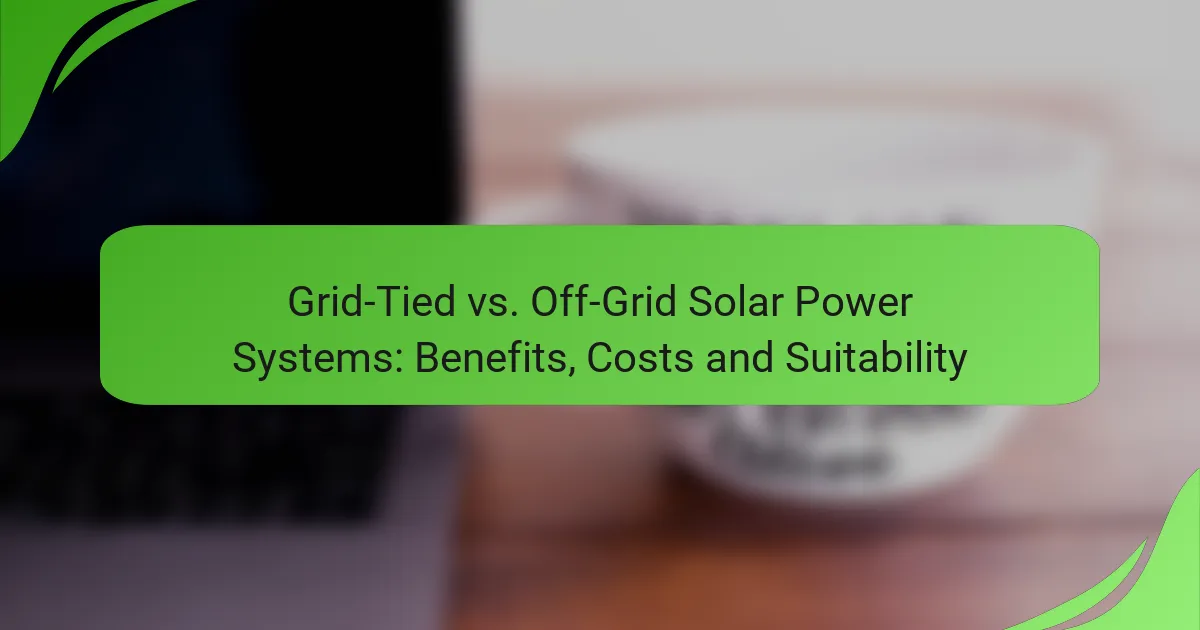When considering solar power systems, homeowners face the choice between grid-tied and off-grid options, each offering distinct benefits and costs. Grid-tied systems connect to the local utility, providing advantages like lower expenses and the ability to sell excess energy, while off-grid systems offer energy independence and sustainability for those in remote areas. Understanding the suitability of each system is essential for making an informed decision about solar energy adoption.
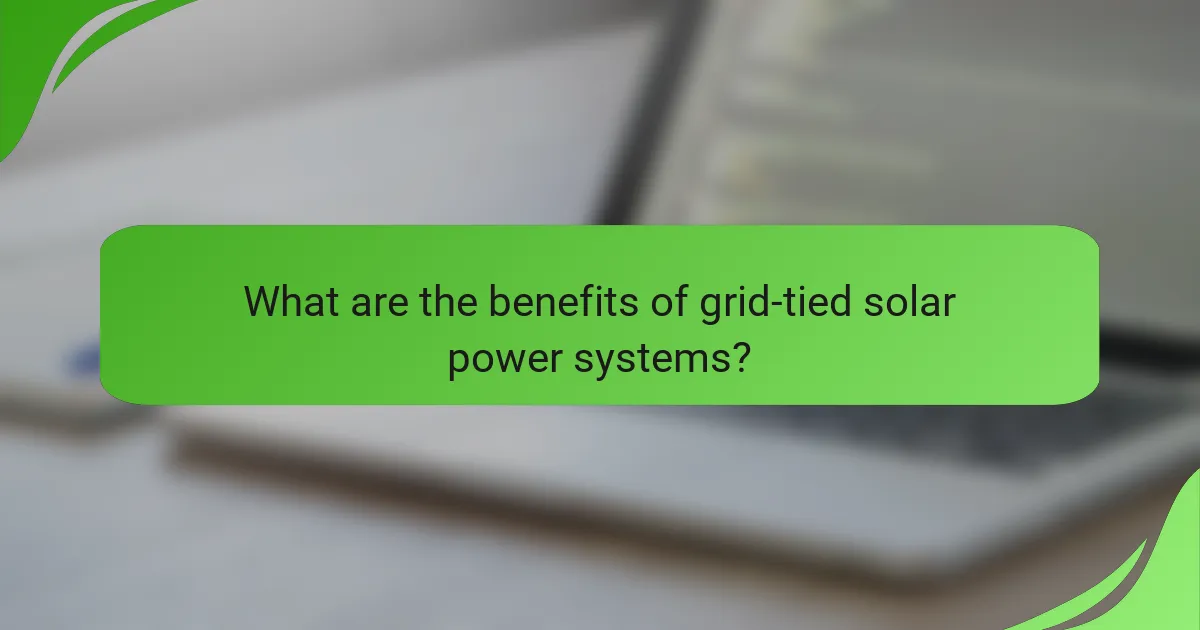
What are the benefits of grid-tied solar power systems?
Grid-tied solar power systems offer several advantages, including lower costs and the ability to sell excess energy back to the grid. These systems are connected to the local utility, allowing homeowners to benefit from net metering and maintain reliable energy access.
Lower installation costs
Grid-tied solar systems typically have lower installation costs compared to off-grid systems. This is largely because they do not require expensive battery storage solutions, which can significantly increase the overall price. Homeowners can expect to pay anywhere from 20% to 50% less for a grid-tied setup.
Additionally, the simplicity of connecting to the existing electrical infrastructure reduces labor and material costs. This makes grid-tied systems a more accessible option for many homeowners looking to invest in solar energy.
Access to net metering
One of the key benefits of grid-tied solar systems is access to net metering, which allows homeowners to receive credits for excess energy they produce and send back to the grid. This can significantly lower electricity bills, as homeowners can offset their energy consumption with the credits earned during sunny days.
Net metering policies vary by state and utility, but many regions in the U.S. offer favorable terms that can enhance the financial viability of solar investments. It’s essential to check local regulations to understand how net metering works in your area.
Reliability during outages
While grid-tied systems rely on the utility grid for power, they can still provide some reliability during outages. If equipped with a backup generator or battery system, homeowners can maintain power for essential appliances even when the grid goes down.
However, without additional storage solutions, a grid-tied solar system will not function during an outage to prevent backfeeding into the grid. Homeowners should consider their energy needs and whether they want to invest in backup options for greater reliability during emergencies.
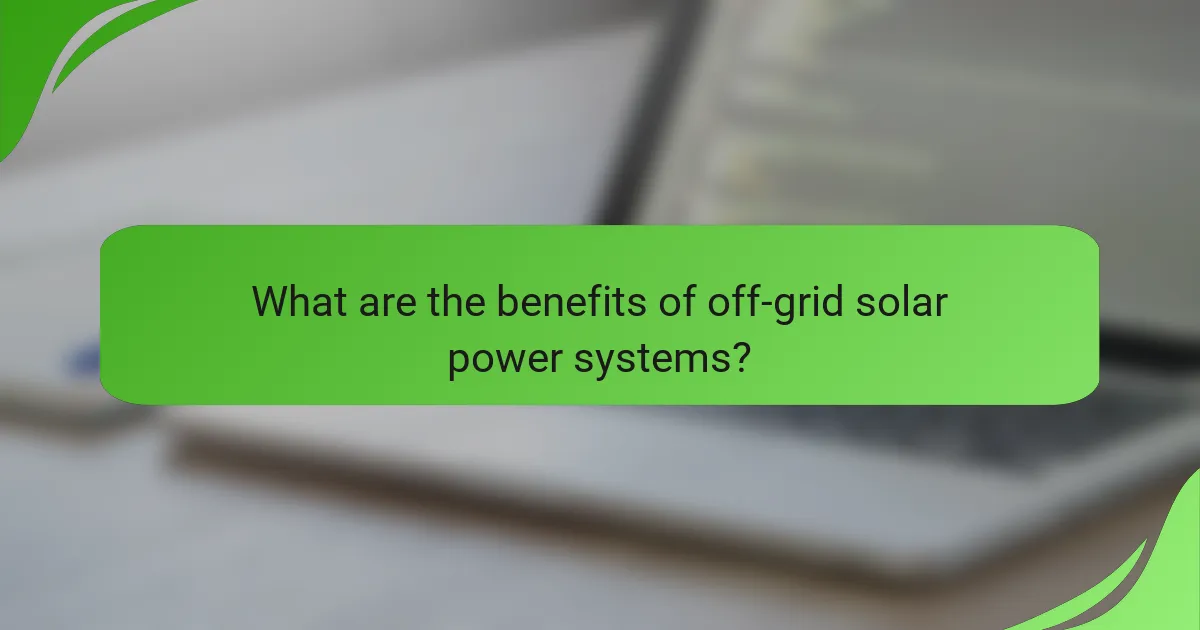
What are the benefits of off-grid solar power systems?
Off-grid solar power systems provide energy independence, lower electricity costs, and promote environmental sustainability. These systems allow users to generate their own electricity without relying on the grid, making them an attractive option for remote areas or those seeking self-sufficiency.
Energy independence
Off-grid solar systems empower users to produce their own electricity, reducing reliance on utility companies. This independence is particularly valuable in regions where grid access is limited or unreliable. By generating power on-site, homeowners can avoid fluctuations in energy prices and potential outages.
To achieve energy independence, it’s essential to size the solar system appropriately based on energy needs. Consider factors such as daily energy consumption, local sunlight availability, and battery storage capacity to ensure a reliable supply.
Reduced electricity bills
One of the primary financial benefits of off-grid solar systems is the significant reduction in electricity bills. By generating power from sunlight, users can eliminate or greatly reduce their monthly utility expenses. In many cases, the initial investment in solar panels and batteries pays off within a few years.
Homeowners should evaluate their energy usage patterns to determine potential savings. For instance, using energy-efficient appliances and optimizing energy consumption during peak sunlight hours can further decrease costs.
Environmental sustainability
Off-grid solar power systems contribute to environmental sustainability by harnessing renewable energy and reducing carbon footprints. Unlike fossil fuels, solar energy is clean and abundant, helping to mitigate climate change and decrease air pollution.
Choosing solar power not only benefits individual users but also supports broader environmental goals. By investing in off-grid solar, homeowners can play a role in promoting sustainable energy practices and reducing dependence on non-renewable resources.
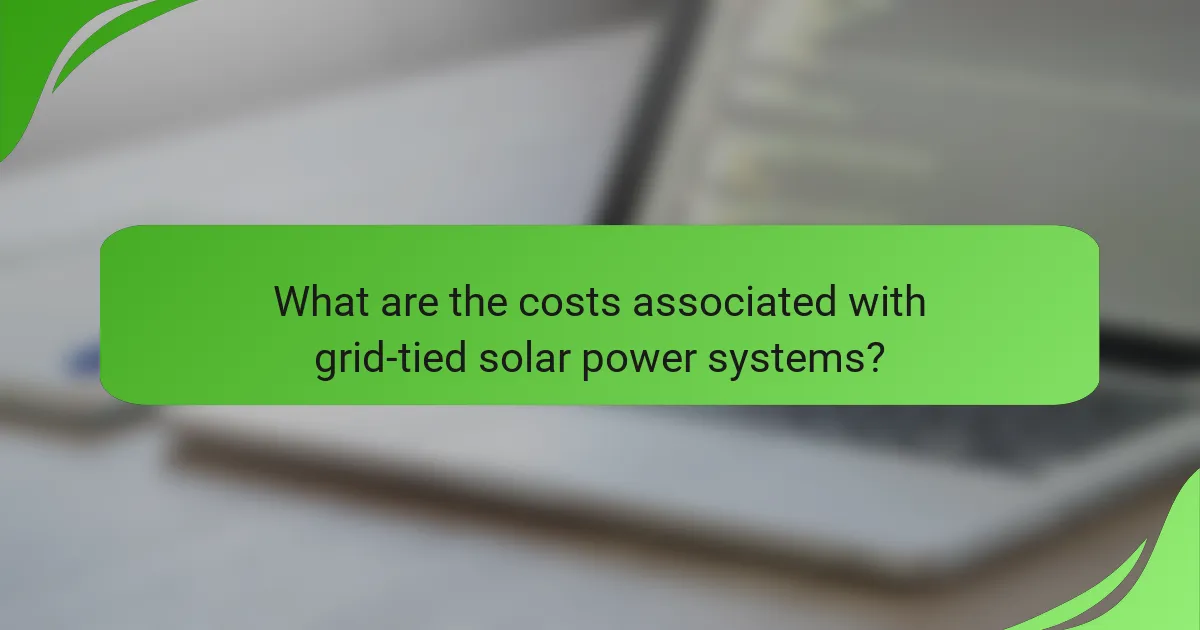
What are the costs associated with grid-tied solar power systems?
The costs of grid-tied solar power systems typically include installation expenses, ongoing maintenance, and potential incentives or rebates. Understanding these costs helps homeowners make informed decisions about transitioning to solar energy.
Average installation costs
The average installation costs for grid-tied solar power systems can range from $15,000 to $25,000, depending on system size and location. This price generally includes the solar panels, inverter, mounting hardware, and labor. Factors such as roof type, local regulations, and the complexity of the installation can significantly influence the final cost.
Homeowners should obtain multiple quotes from reputable installers to ensure competitive pricing. Additionally, consider the long-term savings on electricity bills when evaluating the upfront investment.
Maintenance expenses
Maintenance expenses for grid-tied solar systems are generally low, averaging around $200 to $400 annually. Regular maintenance includes cleaning the panels and checking the inverter and electrical components. Most systems require minimal upkeep, as solar panels are designed to withstand various weather conditions.
It’s advisable to schedule periodic professional inspections to ensure optimal performance and address any potential issues before they escalate. Neglecting maintenance can lead to decreased efficiency and higher long-term costs.
Incentives and rebates
Many homeowners can take advantage of federal, state, and local incentives when installing grid-tied solar power systems. The federal solar tax credit allows homeowners to deduct a significant percentage of the installation costs from their federal taxes, which can substantially reduce the overall expense.
Additionally, some states and municipalities offer rebates or performance-based incentives that can further lower costs. Researching available incentives in your area is crucial, as they can vary widely and may change over time.
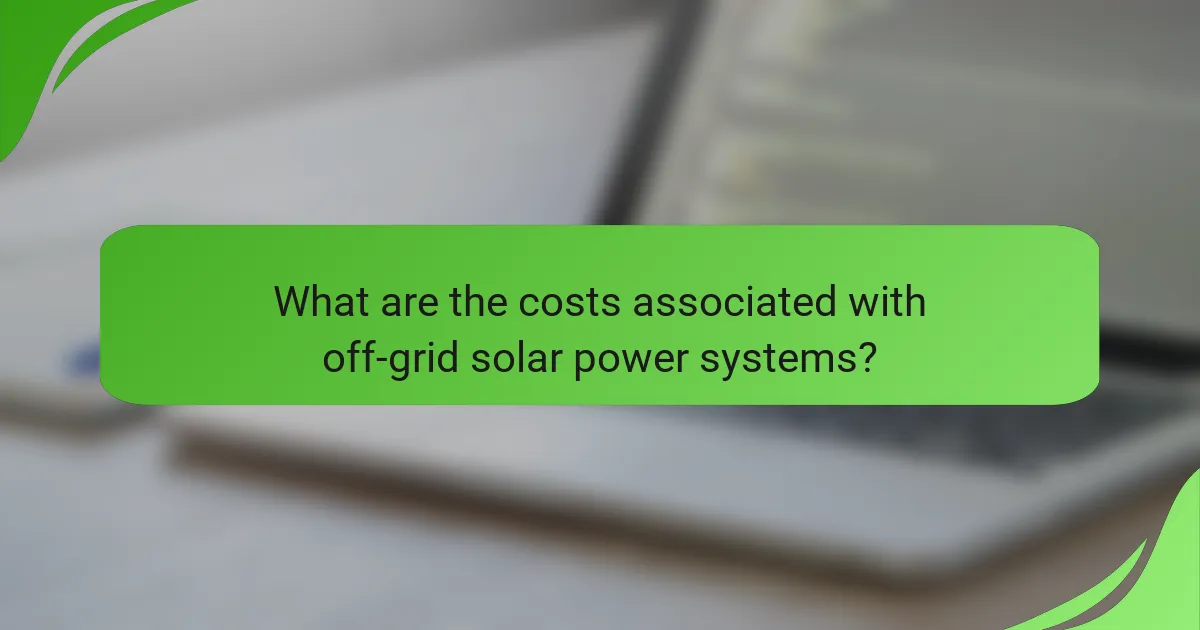
What are the costs associated with off-grid solar power systems?
Off-grid solar power systems typically involve higher initial costs compared to grid-tied systems. These costs encompass equipment, installation, and ongoing maintenance, making it essential to evaluate the financial commitment before proceeding.
Higher upfront costs
The initial investment for off-grid solar systems can range from several thousand to tens of thousands of dollars, depending on system size and components. Key expenses include solar panels, inverters, and installation labor. Homeowners should budget for these upfront costs to ensure a successful setup.
In some cases, government incentives or rebates may help offset these expenses, but it’s crucial to research local programs to maximize savings.
Battery storage expenses
Battery storage is a significant component of off-grid systems, as it allows energy use during non-sunny periods. The cost of batteries can vary widely, with options ranging from a few hundred to several thousand dollars, depending on capacity and technology. Lithium-ion batteries, for example, tend to be more expensive but offer longer lifespans and better performance.
When planning your budget, consider the total energy needs and how much storage capacity is required to maintain a reliable power supply.
Long-term savings potential
While off-grid solar systems have higher initial costs, they can lead to substantial long-term savings on energy bills. By generating your own electricity, you can reduce or eliminate monthly utility costs, especially in areas with high electricity rates. Over time, the return on investment can make these systems financially viable.
Additionally, off-grid systems can increase property value and provide energy independence, which are valuable benefits to consider when evaluating overall costs.
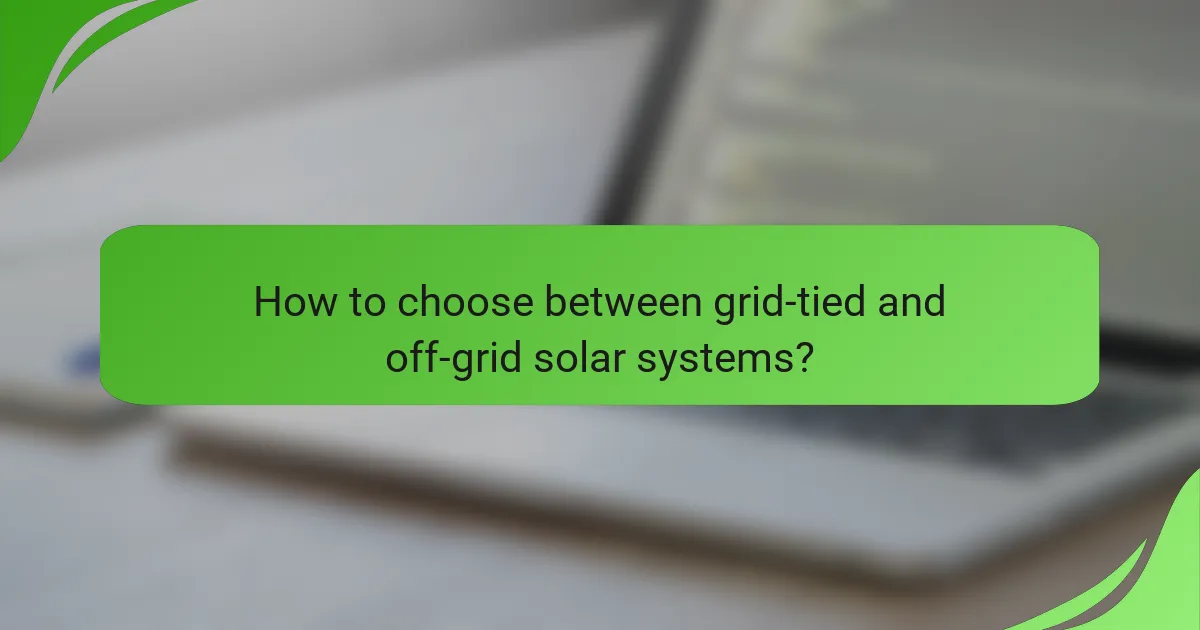
How to choose between grid-tied and off-grid solar systems?
Choosing between grid-tied and off-grid solar systems depends on your energy needs, location, and available resources. Grid-tied systems connect to the utility grid, allowing for energy exchange, while off-grid systems operate independently, requiring sufficient battery storage.
Assess energy needs
Begin by evaluating your household’s energy consumption to determine the appropriate solar system. Consider factors like average monthly electricity usage, peak demand, and future energy needs, such as electric vehicles or home expansions.
For grid-tied systems, you may only need to cover your monthly usage, while off-grid systems must generate enough energy to meet all your needs year-round. A rough estimate is that a typical household may require between 5 kW to 10 kW of solar capacity.
Evaluate location and resources
Your geographical location significantly influences the effectiveness of solar systems. Assess sunlight availability, local weather patterns, and any shading from nearby structures or trees. Regions with high solar insolation will benefit more from solar energy.
Additionally, consider local regulations and incentives for solar installations. Some areas offer tax credits or rebates for solar systems, which can affect overall costs. Researching these factors can help you make a more informed decision about which system suits your situation best.
